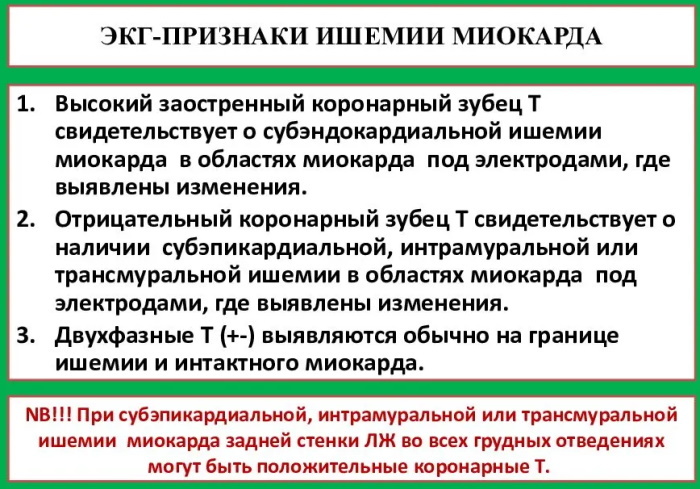Content
- What is obesity and its causes
- Factors affecting weight gain
- Symptoms than dangerous
- The formula for calculating the ideal weight for women, why you need to know the BMI
- Normal weight table by age, height
- Obesity in women
- Generalized table of obesity rates
- Types of obesity by localization of adipose tissue
- "Spacesuit" type
- Fat Belt Type
- Type "Breeches"
- Type "Shield"
- Pants type
- Double belly type
- How to treat obesity, depending on its type, stage
- Stage 1
- Stage 2
- Stage 3
- Stage 4
- Recommendations for lifestyle changes
- Video about obesity in women
Obesity is overweightcaused by metabolic disorders in the body. To calculate the weight index, you must use a special table or formula. However, it should be borne in mind that the calculation is made taking into account gender, and the index itself for women and men will differ.
What is obesity and its causes
Overweight, or obesity, develops as a result of metabolic disorders and is characterized by the accumulation of fat in tissues, organs or under the skin.
Causes of obesity in women:
- hereditary factor (predisposition);
- endocrine disorders;
- psychosomatic disorders (stressful situations, depression);
- long-term use of certain medications (hormonal drugs);
- improper lifestyle - violation of dietary rules, inactivity, lack of physical activity and stress.
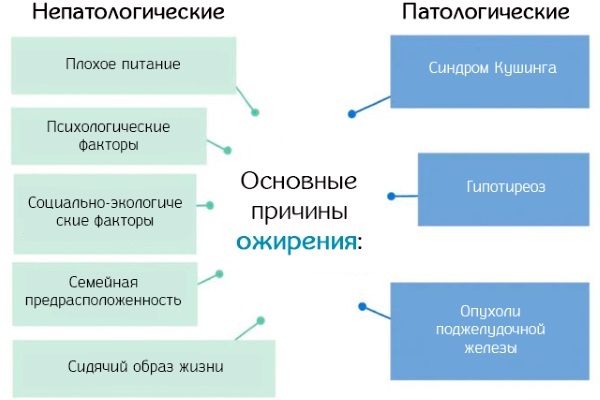
In some cases, overweight can provoke various diseases, especially those associated with the production of hormones.
Factors affecting weight gain
The provoking factors contributing to obesity can be hormonal disorders associated with various physiological changes. Also, excess body weight can occur against the background of pregnancy, with sleep disorders, and be associated with changes in diet (excessive consumption of food or food rich in carbohydrates).
Genetic predisposition can also be a trigger for the development of obesity.
Other risk factors:
- diabetes;
- high blood pressure;
- ischemic diseases;
- stroke.
In some cases, pathology can develop against the background of age-related changes - a decrease in mobility and metabolic processes in the body.
Symptoms than dangerous
The obesity table for women helps to assess the degree of the disease and prevent further progression of the disorder and allows you to consult a specialist at the first symptoms. The main characteristic symptom of the disease is overweight, which can be determined by external signs - the deposition of fat masses in the thighs, abdomen, and chin.
Other symptoms:
- somatic disorders - drowsiness, weakness, irritability;
- shortness of breath, even with minimal physical exertion;
- excessive sweating;
- stool problems (constipation);
- pain in the spine and joints;
- violation of menstruation (in women);
- decreased potency (in men);
- snoring (respiratory distress);
- development of diseases of the cardiovascular system;
- excessive dry mouth;
- increase in blood pressure.
In the absence of any preventive measures, pathology can lead to various complications. In most cases, pathology leads to various psychological problems. However, it can often cause additional health problems.
Possible complications:
- diabetes;
- ischemic heart disease;
- stroke;
- cirrhosis of the liver;
- development of apnea;
- the formation of stones in the gallbladder;
- heart failure;
- arthrosis and arthritis;
- the formation of cysts in the ovarian area;
- in women - disruptions in menstrual cycles, in men - problems with erection and decreased sex drive.
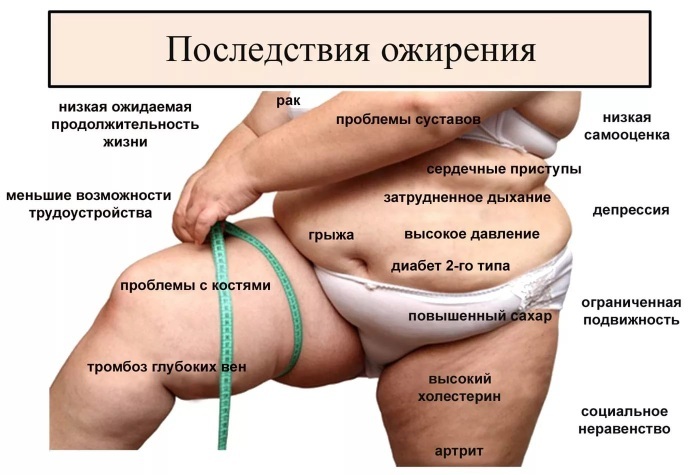
In more severe cases, the disease can lead to the development of malignant tumors - cancer of the breast, uterus or prostate. Also, pathology significantly increases the risks of sudden death.
According to statistics, the death rate in overweight people aged 15 to 70 is 3 times higher than in people of normal weight.
The formula for calculating the ideal weight for women, why you need to know the BMI
You can determine whether you have obesity either by the corresponding symptoms or by using a special formula for body mass index (BMI).
Formula: weight (kg) / height (m2).
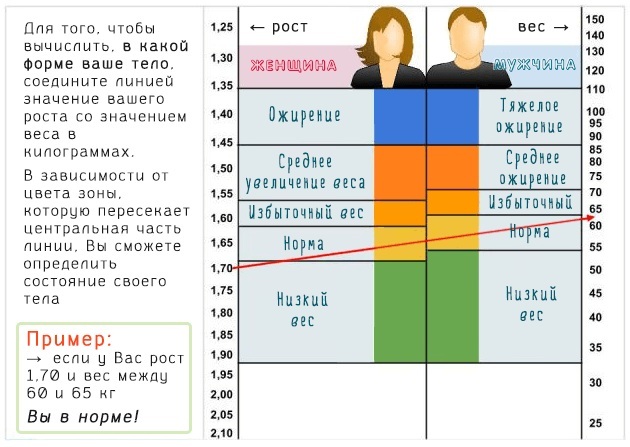
Knowing your body mass index can help you control your weight and adjust your diet to avoid the accumulation of subcutaneous fat.
Normal weight table by age, height
The obesity table for women is compiled according to WHO recommendations and applies to all categories, with the exception of athletes, pregnant women, as well as those who have various diseases leading to edema and, as a result, weight gain body.
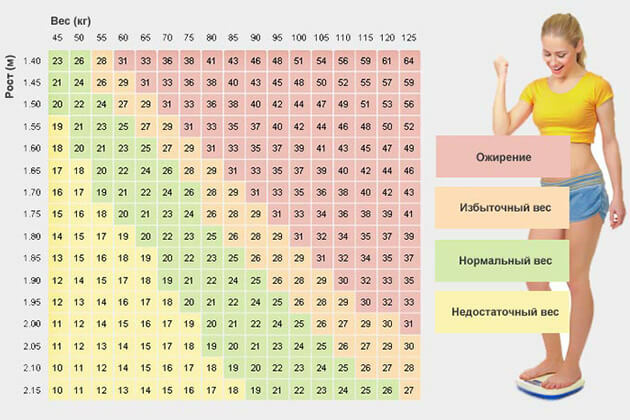
| Height (m) | Age | ||||
| 20-29 (kg) | 30-39 | 40-49 | 50-59 | 60-69 | |
| 1,50 | 48,9 | 53,9 | 58,5 | 55,7 | 54,8 |
| 1,52 | 51,0 | 55,0 | 59,5 | 57,6 | 55,9 |
| 1,54 | 53,0 | 59,1 | 62,4 | 60,2 | 59,0 |
| 1,56 | 55,8 | 61,5 | 66,0 | 62,4 | 60,9 |
| 1,58 | 58,1 | 64,1 | 67,9 | 64,5 | 62,4 |
| 1,60 | 59,8 | 65,8 | 69,9 | 65,8 | 64,6 |
| 1,62 | 61,6 | 68,5 | 72,2 | 68,7 | 66,5 |
| 1,64 | 63,6 | 70,8 | 74,0 | 72,0 | 70,7 |
| 1,66 | 65,2 | 71,8 | 76,6 | 73,8 | 71,4 |
| 1,68 | 68,5 | 73,7 | 78,2 | 74,8 | 73,3 |
| 1,70 | 69,2 | 75,8 | 79,8 | 76,8 | 75,0 |
| 1,72 | 72,8 | 77,0 | 81,7 | 77,7 | 76,3 |
| 1,74 | 74,3 | 79,0 | 83,7 | 79,4 | 78,0 |
| 1,76 | 76,8 | 79,9 | 84,6 | 80,5 | 79,1 |
| 1,78 | 78,2 | 82,4 | 86,1 | 82,4 | 80,9 |
| 1,80 | 80,9 | 83,9 | 88,1 | 84,1 | 81,6 |
| 1,82 | 83,3 | 87,7 | 89,3 | 86,5 | 82,9 |
| 1,84 | 85,5 | 89,4 | 90,9 | 87,4 | 85,8 |
| 1,86 | 89,2 | 91,0 | 92,9 | 89,6 | 87,3 |
| 1,88 | 91,8 | 94,4 | 95,8 | 91,5 | 88,8 |
| 1,90 | 92,3 | 95,8 | 97,4 | 96,6 | 92,9 |
Obesity in women
At the moment, experts distinguish 4 degrees of obesity, depending on the amount exceeded normal weight indicators.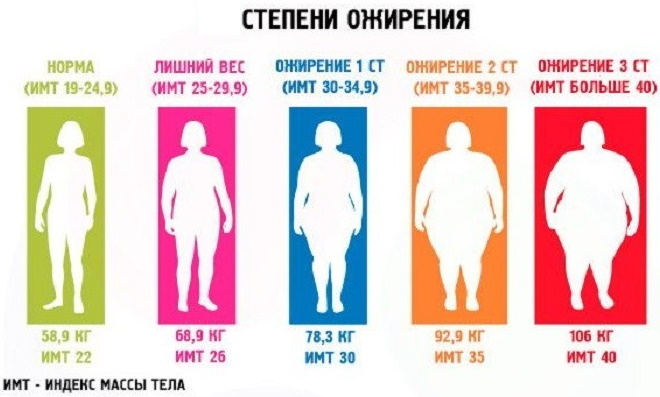
Classification:
- 1st degree. At this stage, there is an increase in body weight by 20-30% of normal values. The condition is not dangerous, no structural changes in organs and tissues are observed.
- 2nd degree. In this case, the patient's weight is increased by 30-39%. The condition is characterized by a significant increase in body fat and the absence of serious health problems.
- 3rd degree. Body weight at the 3rd stage exceeds the norm by 50-100%. At the same time, there is a deterioration in metabolic processes and the development of disorders in internal organs.
- 4th degree. Pathology is diagnosed when the patient's weight exceeds the norm by 100%. In this condition, there is a significant deterioration in metabolism, problems with internal organs become more pronounced.
The 4th degree is considered the most critical and requires outside help, since a person in this state is not able to serve himself.
Generalized table of obesity rates
The BMI table helps to calculate the degree of obesity and identify the risks of comorbid disorders, which can lead to overweight in women.
| Body mass index | Classification | Risks of developing diseases |
| 18,5 | Underweight | Short |
| 18,5-24,9 | Norm | Usual |
| 25-29,9 | Above normal, overweight | Elevated |
| 30-34,9 | High value, 1st degree obesity | High |
| 35-39,9 | 2nd degree obesity | Very tall |
| 40 and up | 3rd and 4th degree of obesity | Extremely high |
The presence of concomitant diseases complicates the treatment of pathology, therefore it is recommended to contact a specialist at the first signs of a violation.
Types of obesity by localization of adipose tissue
Fat deposits can be deposited in different parts of the body. This factor depends on the individual characteristics of the woman's body.
"Spacesuit" type
This form of obesity develops as a result of frequent overeating and abuse of starchy foods and sweets. To cope with the disorder at an early stage, it is recommended to keep a food diary and engage in moderate physical activity (20 min. in a day).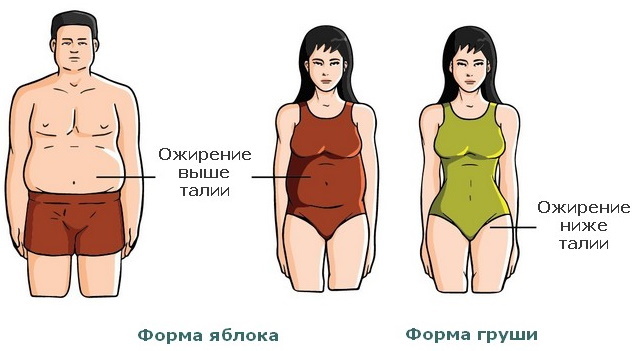
It is also recommended to drink at least 2 tbsp before each meal. water.
Fat Belt Type
The main reasons for this type of overweight are frequent stress, nervous tension and increased anxiety.
Stress seizing often leads not only to fat deposition, but also to other somatic problems, therefore It is recommended that you see a professional who can help you cope with anxiety and stressful situations.
Type "Breeches"
The main triggers of this form of obesity are hormonal disruptions and menopause.
To correct the situation, it is recommended to give up bad habits - alcoholic beverages, smoking. You should also show moderate physical activity and consult a specialist in endocrinology and gynecology to normalize hormonal levels.
Type "Shield"
The main cause of this type of obesity is unhealthy diet. To eliminate the problem, fatty, salty and smoked foods should be excluded from the diet. And add more fresh vegetables to your diet. Additionally, it is necessary to give up alcoholic beverages and smoking. It is also recommended to do moderate physical activity - aerobics, dancing. Ideally, women of this type of figure should adhere to the rules of vegetarianism.
Pants type
The main cause of this form of overweight is a hereditary factor. In most cases, the violation is associated with the condition of the veins, therefore it is recommended to consult such specialists as a phlebologist, vascular surgeon, angiologist. Physical activity is recommended to be directed to the development of legs - walking, climbing stairs.
Double belly type
This type of obesity occurs as a result of lifestyle changes - from active to sedentary. The problem is common among former athletes.
To eliminate the violation, it is necessary to increase daily activity, observe sleep and nutrition regimes (it is necessary to eat regularly, 3 times a day).
How to treat obesity, depending on its type, stage
The obesity table for women helps patients control weight and prevent the development of pathology. The selection of therapy depends on the degree of obesity and the presence of other concomitant diseases. The primary treatment should be prescribed by a nutritionist. However, in most cases, it is necessary to contact other related specialists, based on the cause of the development of the disorder.
Stage 1
First of all, various studies and analyzes are assigned.
Diagnostics:
- examination by an endocrinologist and nutritionist;
- blood test (general, biochemical);
- ECG;
- Ultrasound.
Then, dietary restrictions are set - no more than 1500 kcal must be consumed per day. At the same time, fatty foods, sweets, flour, alcoholic beverages, fast food are excluded from the diet.
They take food fractionally, in small portions every 3 hours. Drink 0.2 liters of water before eating. The last meal should be no later than 3 hours before bedtime.
It is also necessary to increase physical activity. Classes should be given at least 3.5 hours per week. From sports, you can choose light jogging, swimming, exercise equipment, exercises with dumbbells.
Additionally, it is recommended to consult with a psychotherapist.
Drugs are prescribed only with a BMI over 30. In this case, the emphasis is on drugs for cardiovascular diseases.
Stage 2
At the 2nd stage, a standard set of studies is also assigned to assess the patient's health status and establish the cause of the development of pathology.
Treatment methods:
- Nutrition adjustment. The most commonly prescribed diet number 8 according to Pevzner. Drink at least 0.2 liters of cool water before each meal.
- Physical activity. It is recommended to take at least 4-5 hours per week. Activities: walking (including Scandinavian), swimming, exercises with dumbbells, cycling.
- Psychotherapy, behavior correction.
- Cosmetology procedures - liposuction, abdominoplasty.
- Medication. The selection of drugs takes place on an individual basis and only on the advice of the attending specialist. Aids may be prescribed to suppress hunger, increase the activity of the hormone of satiety, and reduce the absorption of fats.
In the absence of a therapeutic effect from the listed methods, surgical methods of treatment can be prescribed. However, such therapy is carried out only with a BMI of more than 35.
Stage 3
With the 3rd degree of obesity, it is necessary to consult and be examined by several specialists at once. Thus, it is recommended to consult a therapist, nutritionist, cardiologist, endocrinologist, psychotherapist and surgeon.
Diet food at this stage is developed individually, however, in any case, the following foods should be excluded from the diet:
- fast foods;
- sugar and sugar-containing foods (including muesli, sauces, ketchup);
- baked goods, pasta, other uncomfortable products;
- grain crops;
- salt;
- alcoholic drinks;
- sausages, semi-finished products, fish and meat that have undergone deep processing;
- milk and dairy products, including cottage cheese;
- fruits and vegetables that contain large amounts of starch and sugar;
- spices and seasonings.
Additionally, psychotherapy is carried out to help establish the cause of overeating.
Also, various drugs are prescribed without fail:
- antidepressants;
- antipsychotics;
- agents that reduce the absorption of fats;
- drugs that increase the satiety hormone;
- drugs to reduce appetite.

Surgical intervention is also performed:
- Bariatric surgery - gastric volume reduction.
- Gastroplasty - removal of part of the stomach or reduction of its volume.
- Gastric bypass surgery - helps to reduce food absorption.
- Stomach Band - Decrease the rate of passage of food and increase rapid satiety.
One way or another is selected individually according to indications and contraindications.
Stage 4
The obesity table for women predicts the possible outcome and risks of developing concomitant diseases, therefore, it is extremely necessary at any age, especially for those who have a predisposition to development violations.
In most cases, stage 4 treatment is performed surgically. However, before this, it is necessary to correct the patient's eating behavior, establish a diet and physical activity, and also carry out therapy for concomitant diseases.
Drug treatment is carried out in extremely rare cases and with great care, since the person's condition in this case is difficult and requires a delicate approach. During the diet, it is recommended to take vitamins of groups A and D (in the form of drops). Also, the patient is recommended shower baths or massage.
Diet nutrition is similar to that in the 3rd stage of the disorder. However, the diet itself is developed by a specialist taking into account the physiological characteristics of the patient.
Other treatments:
- Moderate physical activity with daily increased exercise or activity. Exercises and recommendations - body turns, walking, raising and lowering limbs.
- Physiotherapy - hardware massage (LPG), mesotherapy, hydrotherapy.
- Surgical intervention - liposuction, vertical gastroplasty, gastric bypass or gastric bypass.

During therapy, it is necessary to carefully monitor the patient's health, especially from the spine and cardiovascular system.
Recommendations for lifestyle changes
The main criterion for a successful recovery is a change in lifestyle, therefore psychotherapy is mandatory and included in the complex of the treatment program.
Quitting bad habits, playing sports and eating right is the key to good health and the prevention of the development of not only obesity, but also other health problems.
At the first signs of obesity, especially in young women, it is recommended to check the table BMI and, if necessary, contact a specialist who will help solve the problem early stages.
Video about obesity in women
How to get rid of obesity forever:


